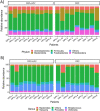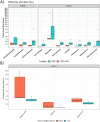Immune landscape and oncobiota in HPV-Associated Colorectal Cancer: an explorative study
- PMID: 37612430
- PMCID: PMC10725376
- DOI: 10.1007/s10238-023-01165-3
Immune landscape and oncobiota in HPV-Associated Colorectal Cancer: an explorative study
Abstract
Worldwide more than 550,000 new patients suffering from malignant tumors are associated with human papillomaviruses (HPV) infection. However, only a small portion of patients infected progress to cancer, suggesting that other factors other than HPV may play a role. Some studies have investigated HPV infection in colorectal cancer (CRC) with discordant results; moreover, the role of HPV in CRC development is still unknown. We investigated HPV infection in 50 CRC from different regions, excluding the anal one, by immunohistochemistry (IHC), real-time PCR and RNA-seq. For each patient, we studied the tumor microenvironment in neoplastic and matched non-neoplastic samples, and we compared the tumor-infiltrating immune cell phenotypes among HPV-positive and negative samples. Finally, we compared the CRC-associated microbiota in HPV-positive and negative neoplastic samples by 16S rRNA sequencing. HPV infection was identified in 20% of CRC from the right side (caecum, ascending and transverse colon) and in 40% from the left side (descending colon and rectum). In all HPV-positive CRCs we found no expression of p53 and RB, thus suggesting HPV involvement in tumorigenesis. As far as the tumor microenvironment is concerned, in HPV-related cancers we observed a neoplastic environment with a reduced immune surveillance but an enhanced cytotoxic response by lymphocytes. HPV-positive and -negative CRC showed a different microbiota with lack of species normally found in CRC in the HPV-positive ones. Our results support the carcinogenic significance of HPV in CRC, suggesting a role of HPV in modulating the tumor immune microenvironment.
Keywords: Bacteroides; Colorectal cancer; Human Papillomavirus; Immune evasion; Immunity; Microbiota; Oncobiota.
© 2023. The Author(s).
Conflict of interest statement
The authors report there are no competing interests to declare.
Figures




Similar articles
-
Detection of HPV and the role of p16INK4A overexpression as a surrogate marker for the presence of functional HPV oncoprotein E7 in colorectal cancer.BMC Cancer. 2010 Mar 26;10:117. doi: 10.1186/1471-2407-10-117. BMC Cancer. 2010. PMID: 20346145 Free PMC article.
-
Human papillomaviruses in colorectal cancers: A case-control study in western patients.Dig Liver Dis. 2017 Apr;49(4):446-450. doi: 10.1016/j.dld.2016.11.003. Epub 2016 Nov 14. Dig Liver Dis. 2017. PMID: 27931969
-
Comprehensive analysis of a novel subtype of immune microenvironment-derived HPV-infected colorectal cancer.Microbes Infect. 2024 May-Jun;26(4):105315. doi: 10.1016/j.micinf.2024.105315. Epub 2024 Feb 27. Microbes Infect. 2024. PMID: 38417673
-
Immune concept of human papillomaviruses and related antigens in local cancer milieu of human cervical neoplasia.J Obstet Gynaecol Res. 2007 Apr;33(2):103-13. doi: 10.1111/j.1447-0756.2007.00492.x. J Obstet Gynaecol Res. 2007. PMID: 17441881 Review.
-
[The tumor microenvironment-relay station for prognosis and therapy response].Pathologie (Heidelb). 2022 Aug;43(Suppl 1):141-147. doi: 10.1007/s00292-022-01159-0. Epub 2022 Nov 21. Pathologie (Heidelb). 2022. PMID: 36414699 Review. German.
Cited by
-
Mendelian randomization analyses support causal relationships between HPV infection and colorectal cancer.Discov Oncol. 2024 Dec 18;15(1):795. doi: 10.1007/s12672-024-01639-0. Discov Oncol. 2024. PMID: 39692780 Free PMC article.
-
Colorectal cancer and gut viruses: a visualized analysis based on CiteSpace knowledge graph.Front Microbiol. 2023 Oct 18;14:1239818. doi: 10.3389/fmicb.2023.1239818. eCollection 2023. Front Microbiol. 2023. PMID: 37928670 Free PMC article.
-
Microbiome Differences in Colorectal Cancer Patients and Healthy Individuals: Implications for Vaccine Antigen Discovery.Immunotargets Ther. 2024 Dec 13;13:749-774. doi: 10.2147/ITT.S486731. eCollection 2024. Immunotargets Ther. 2024. PMID: 39698218 Free PMC article. Review.
-
Bioinformatics Analysis Reveals E6 and E7 of HPV 16 Regulate Metabolic Reprogramming in Cervical Cancer, Head and Neck Cancer, and Colorectal Cancer through the PHD2-VHL-CUL2-ELOC-HIF-1α Axis.Curr Issues Mol Biol. 2024 Jun 19;46(6):6199-6222. doi: 10.3390/cimb46060370. Curr Issues Mol Biol. 2024. PMID: 38921041 Free PMC article.
-
Intestinal dysbiosis and colorectal cancer.Chin Med J (Engl). 2025 Jun 5;138(11):1266-1287. doi: 10.1097/CM9.0000000000003617. Epub 2025 May 19. Chin Med J (Engl). 2025. PMID: 40387510 Free PMC article. Review.
References
-
- Shamseddine AA, Burman B, Lee NY, Zamarin D, Riaz N. Tumor immunity and immunotherapy for HPV-related cancers. Cancer Discov. 2021;11:1896–1912. doi: 10.1158/2159-8290.Cd-20-1760. - DOI - PMC - PubMed
MeSH terms
Substances
LinkOut - more resources
Full Text Sources
Medical
Molecular Biology Databases
Research Materials
Miscellaneous

